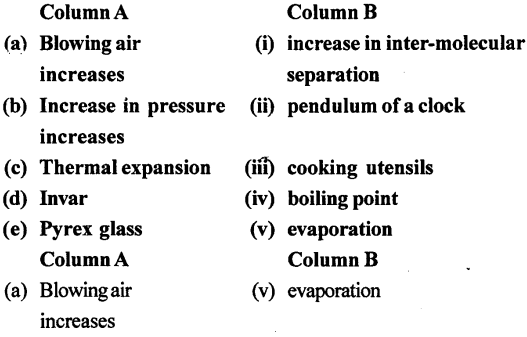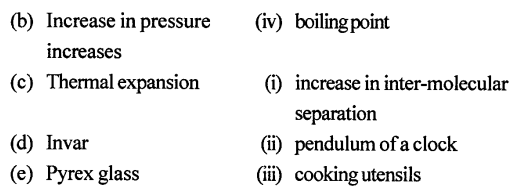Selina Concise Physics Class 8 ICSE Solutions – Heat Transfer
ICSE SolutionsSelina ICSE SolutionsML Aggarwal Solutions
APlusTopper.com provides step by step solutions for Selina Concise ICSE Solutions for Class 8 Physics Chapter 6 Heat Transfer. You can download the Selina Concise Physics ICSE Solutions for Class 8 with Free PDF download option. Selina Publishers Concise Physics for Class 8 ICSE Solutions all questions are solved and explained by expert teachers as per ICSE board guidelines.
Selina Class 8 Physics ICSE SolutionsChemistryBiologyMathsGeographyHistory & Civics
Selina Concise ICSE Solutions for Class 8 Physics Chapter 6 Heat Transfer
- Heat is a form of energy. When two bodies are in contact heat flows from body at higher temperature to body at lower temperature till the lower temperature of both is same.
- When a body is heated, its molecules move faster about their means position and kinetic energy increases and with fall in temperature their K.E. decreases.
- When a substance is heated
(i) It expands i.e. a change in size takes place
(ii) Change in temperature takes place.
(iii) Change in state takes place. - CHANGE OF STATE : “The process of change from one state to another at a constant temperature is called change of state.”
- Solid on heating changes into LIQUID. LIQUID on absorbing heat changes to VAPOURS some SOLIDS on heating DIRECTLY change in vapours called SUBLIMATION. Substance is called SUBLIMATE.
SOLIDIFICATION on cooling when a vapours change into SOLID. GAS OR VAPOURS on cooling \(\xrightarrow { Condensation }\) changes to LIQUID also called LIQUIFACTION. - MELTING: Change of solid into liquid at constant temperature. FUSION ⇒ FREEZING is change of LIQUID into SOLID at constant temperature and change of solid into liquid at a constant _ temperature is called FUSION.
- EVAPORATION: “Change liquid to gas at ALLTEMPERATURES” It is surface phenomenon. “
- VAPOURIZATION : “Change of liquid into vapours at fixed temperature”.
- METING POINT: “Is the temperature at which a solid starts melting and remains constant till the whole of solid melts.”
M.P. is same as freezing point.
M.P. of ice is 0°C or freezing point, of water is 0°C. - BOILING POINT: “Is the temperature of a liquid at which it start, boiling i.e. change into vapours or gaseous state.”
B .P. of pure water is 100°C. - ABSOLUTE ZERO: “The temperature at which molecular motion completely ceases.”
- FACTORS EFFECTING THE RATE OF EVAPORATION :
(i) Temperature: Increases with increase in temperature
(ii) S.A.: Increases with increase in S.A.
(iii) BLOWING AIR—Renewal of air increases evaporation.
(iv) NATURE—Some liquids like spirit, alcohol, petrol evaporate easily. - EVAPOURATION → produces coolness, BOILING produces Hotness.
- LINEAR EXPANSION: When a solid rod (metal) is heated change in length takes place, which depends upon
(i) original length (L0)
(ii) Increase in temperature
(iii) Material of rod.
Let L0 be the original length at 0°C, when heated to T°C final length becomes L
Increase in length (Lt – L0) a L0 (T – 0)
Or
Coefficient of linear expension a which depends upon material of rod.
Lt– L0 = L0 α T
α = Lt – L0 / L0 T = increase in length / original length × Rise in temperature - When a metal plate is heated, change in area takes place and the expansion is called SUPERFICIAL expansion.
- When a solid of volume v0 is heated change in volume called cubical expansion takes place.
- α : β : γ = 1 : 2 : 3
Test your self
A. Objective Questions
1. Write true or false for each statement
(a) Evaporation is rapid on a wet day.
Answer. False.
(b) Evaporation takes place only from the surface of liquid.
Answer. True.
(c) All molecules of a liquid take part in the process of evaporation.
Answer. False.
(d) Temperature of a liquid rises during boiling or vaporization
Answer. False.
(e) All molecules of a liquid take part in boiling.
Answer. True.
(f) Boiling is a rapid phenomenon.
Answer. True.
(g) All solids expand by the same amount when heated to the same rise in temperature.
Answer. False.
(h) Telephone wires are kept tight between the two poles in winter.
Answer. True.
(i) Equal volumes of different liquids expand by the different amount when they are heated to the same rise in temperature.
Answer. True.
(j) Solids expand the least and gases expand the most on being heated.
Answer. True.
(k) A mercury thermometer makes use of the property of expansion of liquids on heating.
Answer. True.
(l) Kerosene contracts on heating.
Answer. False.
2. Fill in the blanks
(a) Boiling occurs at a fixed temperature.
(b) Evaporation takes place at all temperature.
(c) The molecules of liquid absorb heat from surroundings in evaporation.
(d) Heat is absorbed during boiling.
(e) Cooling is produced in evaporation.
(f) A longer rod expands more than a shorter rod on being heated to the same temperature.
(g) Liquids expand more than the solids.
(h) Gases expand more than the liquids.
(i) Alcohol expands more than water.
(j) Iron expands less than copper.
3. Match the following


4. Select the correct alternative
(a) In evaporation
- all molecules of liquid begin to escape out
- only the molecules at the surface escape out
- the temperature of liquid rises by absorbing heat from surroundings.
- the molecules get attracted within the liquid.
(b) The rate of evaporation of a liquid increases when :
- temperature of liquid falls
- liquid is poured in a vessel of less surface area
- air is blown above the surface of liquid
- humidity increases.
(c) During boiling or vaporization
- all molecules take part
- temperature rises
- no heat is absorbed
- the average kinetic energy of molecules increases.
(d) The boiling point of a liquid is increased by
- increasing the volume of liquid
- increasing the pressure, on liquid
- adding ice to the liquid
- decreasing pressure on liquid.
(e) Two rods A and B of the same metal, but of length 1 m and 2 m respectively, are heated from 0°C to 100°C. Then
- both the rods A and B elongate the same
- the rod A elongates more than the rod B
- the rod B elongates more than the rod A
- the rod A elongates, but the rod B contracts.
(f) Two rods A and B of the same metal, same length, but one solid and the other hollow, are heated to the same rise in temperature.
Then
- the solid rod A expands more than the hollow rod B
- the hollow rod B expands more than the solid rod A
- the hollow rod B contracts, but the solid rod A expands
- both the rods A and B expand the same.
(g) A given volume of alcohol and the same volume of water are heated from the room temperature to the same temperature then.
- alcohol contracts, but water expands
- water contracts, but alcohol expands
- water expands more than alcohol
- alcohol expands more than water.
(h) The increase in length of a metal rod depends on
- the initial length of the rod only
- the rise in temperature only
- the material of rod only
- all the above three factors.
(i) The correct statement is
- Iron rims are cooled before they are placed on the cart wheels.
- A glass stopper gets tighten on warming the neck of the bottle.
- Telephone wires sag in winter, but become tight in summer.
- A little space is left between two rails on a railway track.